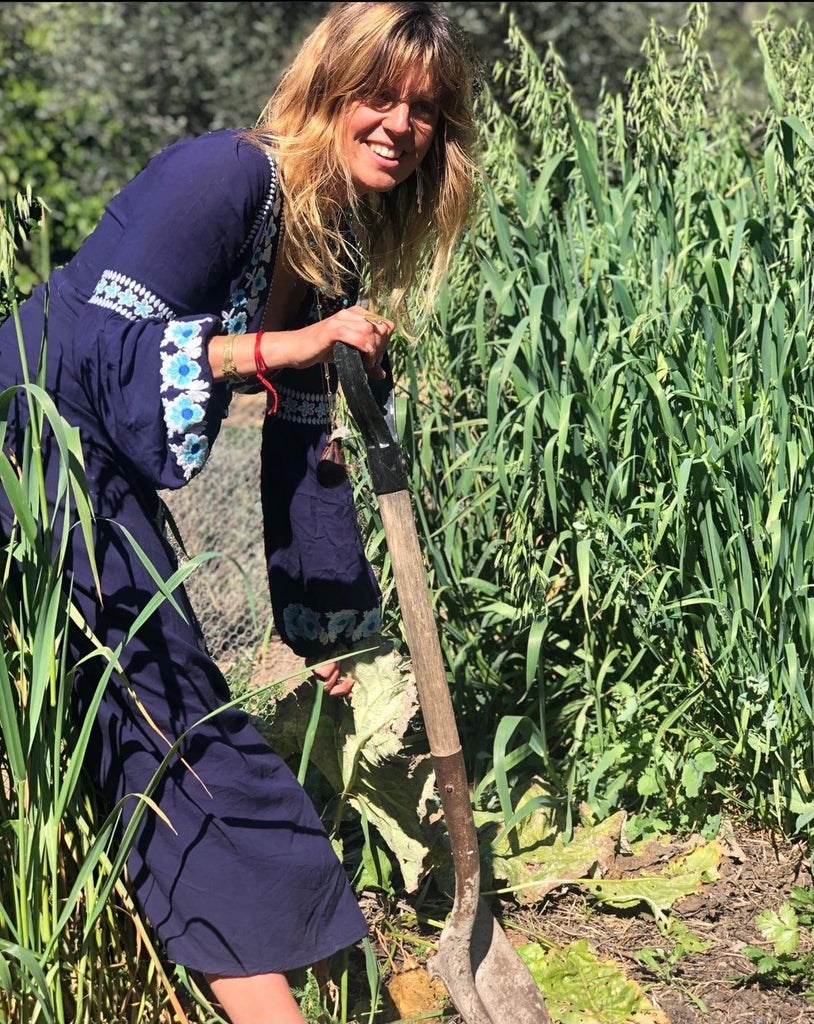Marysia Miernowska is a teacher, author, Earth activist, green witch, folk herbalist and healer rooted in the Wise Woman Tradition of Healing.
A multilingual and multicultural devotee of Mother Earth, Marysia has spent her life traveling, learning and sharing different regenerative ways of tending to the Earth, healing land, and healing people – she’s also the original formulator of Awaken, and a dear friend of Foria since the very beginning.
We were delighted to sit down with her for a wide-ranging chat about regenerative agriculture – as an applied practice for healing the Earth, and as a powerful narrative for healing our culture, our society, and ourselves.
For more from Marysia, check out her website and courses, and follow her on Instagram.
 Explain it to me like I’m five – what is regenerative agriculture, exactly?
Explain it to me like I’m five – what is regenerative agriculture, exactly?
Regenerative agriculture is a practice of tending to the earth and natural ecosystems, in order to support the earth in regenerating herself. It is a way of being in relationship to the earth and the land, to feed the vital forces of renewal.
Some of the practices of regenerative agriculture include building soil health, supporting the natural water cycle, planting for pollinators, preserving heirloom seeds and seed diversity, working with diverse human communities, preserving culture and tradition, and creating and supporting relationships of reciprocity.
Some of the specific tools that we use for building soil health include composting, planting cover crops, mulching the earth, covering the earth so it doesn't get baked by the sun. Planting different trees with deeper root systems to bring carbon into the soil, to replenish groundwater and moisture in the soil. Planting food, working with [human] communities in a way that goes beyond fair trade. And planting diverse plants, diverse seeds, native plants, pollinator plants – those are some of the specific techniques in regenerative agriculture that we use.
How did you come to regenerative agriculture as a component of your own practice?
I'm a folk herbalist, and I was taught by my grandmothers to tend to the earth, to speak to the plants, to learn from the plants about their medicinal properties. And I carry this folk tradition of European traditional herbalism, which includes tending to the garden, and tending to the family and human community by growing food.
Many of the practices that are often unnamed and practiced by traditional people include regenerative practices. They include farming in harmony with the moon cycles, they include composting, they include planting to support the vitality of the ecosystem that we're living in. Now we're putting names onto things, which can be really helpful, especially to those of us who are wanting to understand what we are doing and who want to bring more regenerative practices into our lives.
But a lot of the practices of regenerative agriculture are just traditional, foundational practices that come from people who have been in deep relationship with the earth. Crop rotation, cover cropping, these are things that have been practiced for a very long time. So I came to the named field of regenerative agriculture through my work here in Southern California.
As an educator, all of my work comes down to creating bridges between people and land. And when I moved to Los Angeles, I noticed that the land here, which I fell deeply in love with, was really struggling. I was hearing the mountains telling me how depleted they were – how brittle and dry and how much they lacked nourishment and love, and nourishment from people.
And as a healer and herbalist, when I got connected to the people in Los Angeles, I noticed a theme – which was also depletion, a lack of nourishment, a lack of groundedness. And my work has always been about creating opportunities for the people of this area and the land to develop nourishing relationships, to fall in love with one another. Because in my work, I found that as people fall in love with the earth and learn to care for the earth, they also receive deep nourishment and heal themselves.
So it's Earth care as self-care, that's my work. Regenerative agriculture just offers a very clear set of tools and practices, and ways where we can notice really quick changes on the properties that we live on. I have students who just have a sidewalk strip in front of their homes, and they'll plant cover crops there. And then their neighbors are like, “what are these sweet peas growing everywhere?” And there's pollinators, and then, five months later, from this brick of dry soil where they planted this cover crop there's rich dark soil, and they plant flowers and a bee garden, and their whole neighborhood begins to change, get inspired, learn, and receive nourishment.
People just awaken when they feel the earth alive. It awakens something inside of us. So it's been really phenomenal to be in this field and to support my students and my community, and to share these practices.
If you were talking to someone who had encountered this idea and found it resonant for them, but wasn’t sure where to get started, what would you tell them?
I would tell them that it starts with self-compassion. It starts with grieving, and with acknowledging that we were born into an extractive system, and that extractive system lives inside of us. And we can only heal it by self-compassion. The seed is inside of us. And it's a seed that we were born into. So radical self-compassion, compassion for others, is the fertile foundation for our gardens to thrive.
And then from there, just curiosity and play, coming into this renewal of relationship with the earth from that archetype of a young child that is curious and wants to engage, and knowing that we can touch the earth. We are resilient, and we are part of this living earth. And from that place of play and curiosity, it can be really fun to get curious about what we can do in our own homes and in our own little worlds.
One of the best things to get started with is composting. When we're at home, and we have our kitchen scraps or leftover food, all of that is amazing vitamins, and food that helps feed and repair the soil. When we put it in our garbage it ends up in a landfill, and it can no longer become nutrition that repairs the earth. As the food waste rots in the landfills, it creates methane gas, which goes back into our atmosphere and causes more pollution. But when we put it into a compost bin, or just even throw it in the garden or under a bush, it decomposes and feeds the bacteria in the soil, which allows the soil to absorb more rainwater, allowing, he soil to be rich and alive.
And it's so fun, and it's so rewarding, because you instantly start to see how much food you are producing. And to know that that's something that you can give to the earth is really rewarding, and it's very easy. People can have worm bins if they live in a small apartment, they can have a closed compost tumbler if they live in a neighborhood and smell is a concern.
When I used to be a single mom living in a tiny one-bedroom apartment with my daughter, and couldn't really compost the way I wanted to, I just had a little hole under a bush in my apartment building and I would just throw my food scraps there. And over the months that I lived there, this little strip between my apartment and the sidewalk began to become this incredible little place with wildflowers and with bees and butterflies and people in my neighborhood would stop and look. So there's so much magic that we can bring in in such simple ways.
Planting trees is an incredible thing that we can do. When we plant trees we create shade, we create wildlife habitat. I love the saying “The best time to plant a tree was 20 years ago, the second to best time is now.” If we plant fruiting trees, we're creating food, shade, cooling the air, bringing water into the small water cycle. So planting trees is one of the most important things that we can do. And if we live in a house with a lawn, or with a little bit of land connected to it, it's incredible how much food we can grow in a small amount of space.
So growing our own food, replacing a lawn with native plants that use less water, and that feed the pollinators and replenish the soil. It's amazing what we can do in just our homes and our little properties.
But it really starts with self-compassion. And with regenerating our love of ourselves as part of the earth and regenerating our love for the earth – falling back in love with Earth.
There's something really empowering about the idea that you can embrace these principles without committing to being a super-intimidating urban homesteader. You could just be a dirt farmer, theoretically.
It's really important, because we're not all farmers and we're not all meant to be, and in these times, we need all of us to be really connected to our own unique gifts. This comes back to power dynamics. It's not about all of us becoming something else, that's all exactly the same.
That is part of the root of the illness of our capitalistic culture. What I equate it to, when I compare the story of capitalism to the garden and the farm, I think of it like capitalism wants us to be like GMO corn that's growing in rows, addicted to a drip system of artificial nutrients. And we all have the same needs, and grow in the same way, and we all look the same.
And the cosmology that I come from, the tradition of herbalism that I come from, and regenerative agriculture too, it's about creating this fertile, diverse wild garden. And so for us as humans, it is so important for us to be our own selves, and not try to go become a regenerative ag farmer. That's not what it's about. It's about us getting to know ourselves, and knowing what our unique gift is to contribute to this beautiful, regenerating web of life. And then to live in a way that replenishes these forces so that we can receive from it too and feed life for those who are yet unborn.
What are your thoughts about the intersections between the summer solstice, regenerative agriculture and the cycle of the seasons?
I think in general, people may say to themselves “okay, cool. Regenerative agriculture is cool, but what does it have to do with me?” And what's really important is to recognize that all of life on this planet is constantly renewing itself and dying. And without death, there is no life and renewal. And this is important for all of us. Because when we live in harmony with nature, we can renew our own energy, our own vitality and creativity. We can really embody these seasons of thriving.
And regenerative agriculture is all about feeding, and actively participating in, this cycle of life, death and renewal.
Summer is a peak moment, when flowers are turning to fruit, when the days are the longest, when the land and the earth are producing all of this abundance which will help us get through the fall and the winter, so we will have seeds to plant again in the spring. But it cannot exist without all of the other moments and all of the other seasons.
And that makes us a little bit more sensitive to nuance, regenerative living, and regenerative agriculture, and modern living, which is so focused on just the summer aspect.
And there's an interesting parallel between the summer season and capitalism. Modern capitalistic culture is always putting the spotlight on this perpetual summer. And our culture is all about constant growth, forever expansion, always being in the limelight. These are all beautiful things when they're part of a balanced ecosystem. But when we are constantly pushing expansion and growth and productivity, forever growth, it's cancerous. There's nothing in nature that grows forever.
And this is what leads to this devastation that we're experiencing ecologically, it leads to a lack of balance. It leads to people burning out, right? That element of fire, of the sun, when you're in it for too long, you burn out.
When we are living in a perpetual summer, or when we are buying into this false illusion of capitalism and an extractive economy, then we are depleting the earth. Literally and energetically, we're depleting her resources, and we're depleting ourselves. And so what I see as a healer, in people that I work with, is depletion, and I [also] see it in the earth. It's one and the same. So participating in any regenerative practices helps renew the earth, helps renew us, helps renew our relationship, helps create relationships of reciprocity.
And so in regenerative agriculture, we are feeding all moments of the life-death-renewal cycle. We are nature, and what we can do as humans is use our intention and our consciousness to participate in feeding the cycle of life, death and renewal.
Featured in this article
Want more? Sign up for our newsletter
By entering your email, you are agreeing to our terms and conditions and understand our privacy policy.














